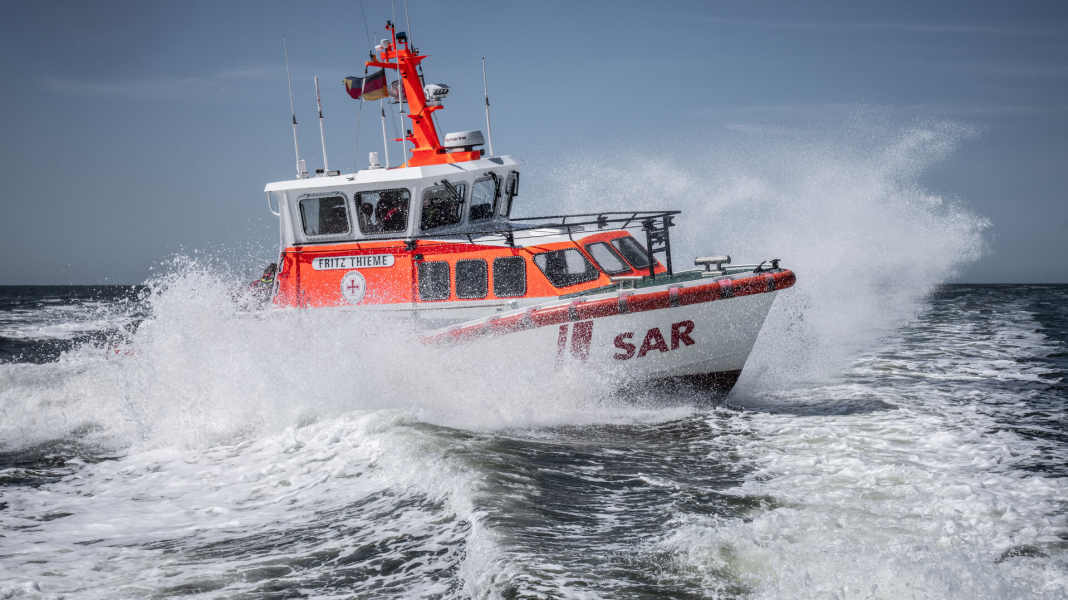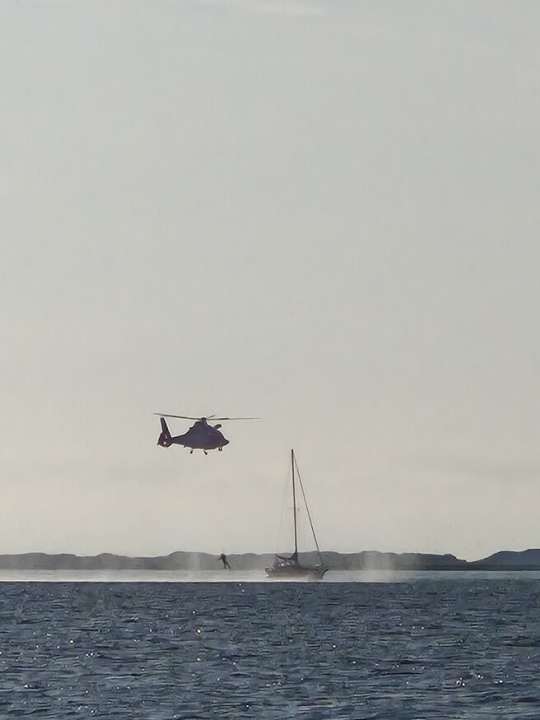
- Challenging conditions in the Wadden Sea
- Coordinated rescue operation
- Life-saving emergency measures
- What Segl he can do in an emergency
- Expose the airway: The recovery position at sea
- Control your breathing: The 10-second rule
- Initiate cardiopulmonary resuscitation: Maritime CPR techniques
- Preventing hypothermia: keeping warm at sea
- Make an emergency call: Effective communication in an emergency at sea
- Preparation for possible patient transport
- Learn more:
On Friday evening, an emergency call reached the German Maritime Rescue Coordination Centre of the German Maritime Search and Rescue Service (DGzRS) in Bremen: A man had collapsed on a sailing boat in the mudflats of Spiekeroog and was temporarily unconscious. The patient's wife alerted the sea rescuers by telephone shortly after 6 pm. A rescue operation was immediately initiated, which involved the rescue helicopter "Northern Rescue 01" as well as the rescue boat "Fritz Thieme" from Wangerooge.
Challenging conditions in the Wadden Sea
The rescue workers were faced with a difficult task: the sailing boat, which was around ten metres long, had drifted out of the fairway into shallow water and run aground. Even the comparatively small rescue boat could no longer reach it. The rescue helicopter arrived at the scene of the emergency at around the same time as the rescue boat. From there, an emergency paramedic was dropped directly onto the sailing boat, while the emergency doctor and other equipment were winched to the sea rescuers on the "Fritz Thieme". Light winds and smooth seas favoured the manoeuvres, which required great precision.

Coordinated rescue operation
While the paramedic attended to the patient, his wife was able to take the helm and steer the sailing boat into deeper water. The lifeboat took the yacht alongside so that the emergency doctor could also go on board. For medical reasons, it was decided to continue treating the patient on board for the time being and to carefully tow the sailing boat to Wangerooge, where the tow arrived shortly after 8 pm. As the helicopter was unable to land at Wangerooge harbour, an ambulance was waiting there to take the patient to the airfield. From there, the patient was finally transported by helicopter to a hospital on the mainland. The crew of the "Fritz Thieme" helped the sailor to moor her boat safely in the marina.
Life-saving emergency measures
The wife of the man who had fallen ill so suddenly was given first aid instructions by telephone by the incident commander until the emergency services arrived. Even if a rescue operation is initiated immediately, it can take some time for the rescuers to arrive. For example, the volunteer sea rescuers from Wangerooge first have to get to the harbour, which is around 5 kilometres from the town centre, and then navigate through the Seegatt into the Spiekeroog mudflats. The rescue helicopter "Northern Rescue 01" called in this case is stationed in Sankt Peter-Ording and is ready for action within 15 minutes at the latest; the flight takes around 20 minutes more. With just over 30 minutes between the emergency call and the arrival of the rescuers, this was a quick operation. On board, however, every minute counts in such cases.
What Seglhe can do in an emergency
Even in relative proximity to land, unconsciousness can quickly become life-threatening. Even more so at sea, when the skipper and crew have to act quickly and effectively away from professional help. Quick action is required if an unconscious person is on board. Possible causes of unconsciousness at sea range from accidents with head injuries and poisoning from medication or alcohol to hypothermia, heatstroke or heart attack. The exact cause can often not be determined immediately, which is why securing vital functions is the top priority.
Firstly, the person's state of consciousness is assessed. The AVPU check (Alert, Voice, Pain, Unresponsive) has proven effective for this. Speak to the person out loud and touch their shoulders. Do they respond to the alert? If not, call out loudly and gently shake their shoulders (Voice). If there is no reaction, check by applying a pain stimulus, for example by rubbing the sternum (Pain). If there is no reaction to this either, the person is considered unresponsive. This systematic check enables a quick assessment of the situation and determines the further measures to be taken.
Expose the airway: The recovery position at sea
If a person is unconscious but breathing, the recovery position is life-saving in order to keep the airways clear. At sea, however, this requires adaptation. Position the person so that their head is slightly raised and facing the bow. This prevents them from rolling back onto their back in the event of waves. Secure the position with rescue blankets or cushions. Check breathing regularly and adjust the position if necessary. The maritime recovery position requires constant attention, as conditions on board can change quickly.
Control your breathing: The 10-second rule
Breath control is particularly challenging at sea. Apply the 10-second rule: Watch the chest and abdomen for movement for 10 seconds while keeping your ear close to the person's mouth and nose to hear breathing sounds and feel the airflow. Pay attention to the peculiarities of breath control at sea - ship movements can simulate breathing movements. Count the breaths during this period. Less than two breaths in 10 seconds indicate inadequate breathing and require immediate resuscitation measures.
Initiate cardiopulmonary resuscitation: Maritime CPR techniques
Performing cardiopulmonary resuscitation (CPR) at sea requires special techniques. Position the person on a stable surface, ideally in the cockpit or saloon. In waves, the classic 30:2 technique (30 compressions, 2 ventilations) can be difficult. Focus on continuous chest compressions at a rate of 100-120 per minute. Use the rhythm of the song "Stayin' Alive" to set the pace. Take special care when ventilating - make sure the mouth is tightly sealed to prevent salt water from entering. The use of a resuscitation bag can be helpful here.
The use of an automated external defibrillator (AED) can also be life-saving at sea, but requires special precautions. Dry the person's chest thoroughly to ensure effective adhesion of the electrodes. Ensure that no water comes into contact with the device or the electrodes. Position the AED in a sheltered place to protect it from splashing water. Follow the device's instructions exactly and ensure that nobody touches the person or the boat while the shock is being delivered. Correct use of the AED in maritime conditions can significantly increase the chances of survival.
Preventing hypothermia: keeping warm at sea
Prevention of hypothermia is critical in the event of unconsciousness at sea. Remove wet clothing and wrap the person in rescue blankets, paying particular attention to protecting the head, neck and torso. Use additional dry blankets or sleeping bags. Improvise a layer of insulation between the person and the cold deck floor, for example by using life rafts or life jackets. Continuous monitoring of body temperature is essential - if there are signs of hypothermia, intensify warming measures and prepare for a possible evacuation.
Make an emergency call: Effective communication in an emergency at sea
Making the correct distress call at sea can be the difference between life and death. Use the international emergency call channel 16 on VHF or activate the DSC emergency call (Digital Selective Calling). If you have mobile phone coverage, you can also call the DGzRS Maritime Rescue Coordination Centre on the number +49 421 536 87 0 possible. Ideally, this number is stored in the mobile phone's speed dialling list. Only near the coast and only from German mobile phone networks can the See rescue coordination centre also be contacted via the speed dialling code 124 124 (without dialling code). However, this is not an emergency number, but a service number of the network operator. The DGzRS has no influence on availability.
Once contact has been established with the sea rescuers, provide precise information: Position, type of emergency, description of the boat, number of people on board and assistance required. If possible, stay in constant contact with the rescue services and inform them of any changes in the situation or position.
Preparation for possible patient transport
Depending on the severity of the condition and the distance to the nearest harbour, an evacuation may be necessary. The crew should prepare for this by making the patient fit for transport and compiling all important medical information and documents. In the event of a helicopter rescue, the deck must be cleared of loose objects and a suitable pick-up area prepared. The exact procedure is usually communicated by the rescue service via radio.
Learn more:
In the YACHT podcast, Dr Timo Spanholtz explains how to treat medical emergencies on board correctly.
Our new two-part webinar starts in autumn: Emergency medicine on board. The webinar consists of two parts: Internal emergencies and acute treatment and Surgical emergencies and first aid for injuries. Click here to register.

